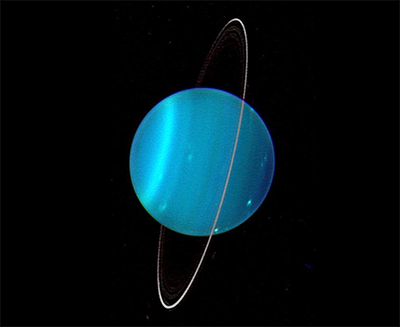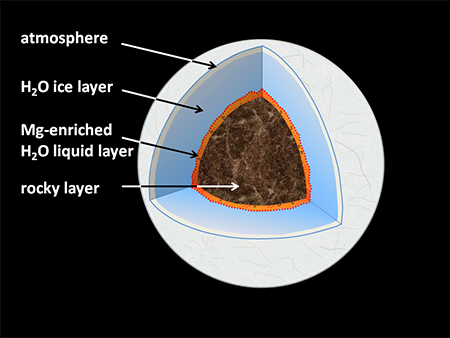| May 18, 2021 |
Deep oceans dissolve the rocky shell of water planets
|
|
(Nanowerk News) High-pressure experiments show that the hidden oceans of water planets selectively leach magnesium from typical rock minerals at conditions of pressures of hundred thousand atmospheres and temperatures above one thousand degrees Celsius.
|
|
An international research team led by Taehyun Kim of the Yonsei University in South Korea reports its findings in the journal Nature Astronomy ("Atomic-scale mixing between MgO and H2O in the deep interiors of water-rich planets"). The observations are also significant for our picture of the history of the planets Uranus and Neptune in our own solar system.
|
 |
| At an average distance of three billion kilometers, the ice giant Uranus is about 20 times as far from the Sun as the Earth. (Image: Lawrence Sromovsky, University of Wisconsin-Madison/W.W. Keck Observatory)
|
|
“The mechanisms of water-rocks interaction at the Earth surface have been studied for many decades,” says last author Yongjae Lee from Yonsei University. “However, there is no understanding of what happens in icy planets were hot, dense water interacts with the deep rocky shell at pressures and temperatures much higher than at the bottom of the deepest oceans on Earth.”
|
|
Kim's team performed a series of high-pressure and high-temperature experiments in a diamond anvil cell both at DESY's X-ray light source PETRA III and the Advanced Photon Source in Argonne (USA) that demonstrate how water strongly leaches magnesium oxide (MgO) from the minerals ferropericlase (Mg,Fe)O and olivine (Mg,Fe)2SiO4 at pressures between 20 and 40 gigapascals (GPa), corresponding to between 200,000 and 400,000 times the atmospheric pressure at sea level, and temperatures above 1230 degrees Celsius, conditions that are encountered at the interface between the deep ocean and the rocky mantle inside sub-Neptune class of water planets. These findings also have a direct impact on the thermal history of large icy planets such as Uranus and Neptune.
|
|
“For the experiments, tiny pellets of either ferropericlase or olivine powder were loaded together with water in a submillimetric sample chamber drilled in a metal foil and squeezed between two gem-quality diamonds culets using the diamond anvil cell,” explains Kim. “The samples were heated by shining an infrared laser through the diamond anvils.”
|
|
Synchrotron X-ray diffraction was used to determine the mineral breakdown induced through the interaction of H2O with the minerals. A sudden decrease of diffraction signal of the starting minerals, and the appearance of new solid phases including brucite (magnesium hydroxide) was observed across all heating and quenching cycles.
|
 |
| Cutaway sketch of a typical icy planet. (Image): GFZ, Sergio Speziale)
|
|
This demonstrates the onset of chemical reaction and dissolution of the magnesium oxide component of both ferropericlase and olivine. The dissolution is strongest in a specific pressure–temperature range (20 to 40 GPa and 1000 to 1750 degrees Celsius).
|
|
The details of the reaction process and the consequent chemical segregation of magnesium oxide from the residual phases were confirmed by thorough Scanning Electron Microscopy (SEM) and X-ray spectroscopy of the recovered samples. At these extreme pressures and temperatures the solubility of magnesium oxide in water reaches levels similar to that of salts in the Earth’s ocean at ambient conditions. This means, the deep waters of Uranus and Neptune could be magnesium-rich.
|
|
The findings are not only relevant for studying planets of our own solar system, but also for the investigation of so-called exoplanets beyond our system.
|
|
“Intensive dissolution of magnesium oxide at the interface between the water layer and underlying rocky mantle could produce, in water-rich exoplanets with appropriate size and composition such as TRAPPIST-1f, chemical gradient with fuzzy boundary between the layers,” says Lee. “In the case of large icy planet such as Uranus, tracks of initial relatively shallow interactions between water and rocky material during the early, hot phases of planetary accretion could also be metastably preserved for billions of years in its present topmost water-rich mantle, explaining its unusually low surface luminosity.”
|
|
Scientists from Yonsei University in South Korea, the University of Chicago, the University of Illinois, GFZ German research Center for Geosciences, Arizona State University and DESY participated in the study. The study is part of the Early Science Program of the Centre for Molecular Water Science (CMWS) that is currently being set up at DESY, and associated to a long-term project of Yongjae Lee at the Extreme Conditions Beamline P02.2 at PETRA III.
|


